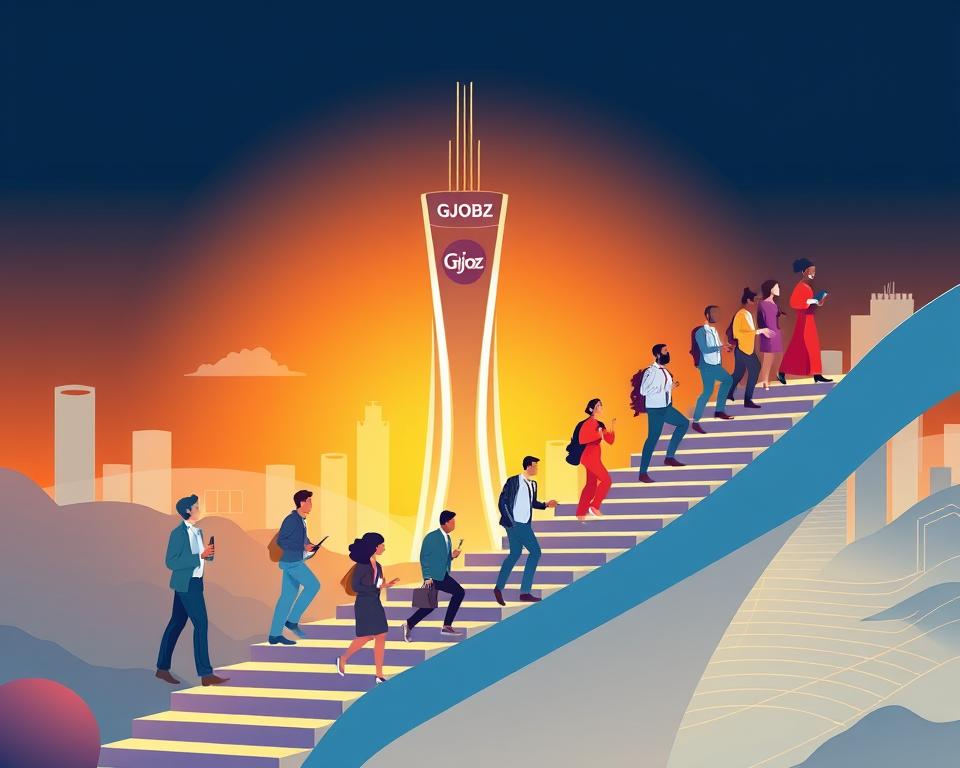
Reskilling solutions for high-potential employee pipelines
Businesses face a paradox: 9.5 million U.S. jobs sit unfilled while 5.8 million workers actively seek employment. This gap stems from evolving skill demands and outdated hiring practices. Traditional recruitment often fails to address rapid industry shifts, leaving organizations scrambling for qualified candidates.
Forward-thinking companies now prioritize building talent internally through strategic pipelines. These systems identify high-potential team members early, offering tailored training to prepare them for leadership or technical roles. For example, a major tech firm reduced hiring costs by 40% after creating a pre-screened internal candidate pool.
Challenges like the Great Resignation accelerated this trend. Organizations losing top performers need continuous talent supply chains to maintain operations. Data shows companies with active pipeline programs experience 33% less productivity loss during leadership transitions.
Modern workforce planning combines skills assessments with predictive analytics. This approach helps managers anticipate future needs while closing competency gaps through targeted development. When paired with mentorship programs, employees gain clear growth paths that boost retention by 28%.
Key Takeaways
- Skill mismatches drive 83% of unfilled positions despite available workforce
- Internal talent pools cut hiring costs by 40% compared to external searches
- Proactive pipeline development reduces leadership transition downtime by 33%
- Data-driven programs increase employee retention rates by 28%
- Combining assessments with training creates adaptable workforce structures
Understanding the Modern Talent Pipeline
Companies are shifting focus from external hiring to internal development to stay agile. A modern talent pipeline acts as a dynamic system that identifies and prepares qualified candidates – individuals with verified competencies matching specific roles. This approach combats the skills gap, where 72% of employers report mismatches between job requirements and applicant abilities.
Core Components of Effective Pipelines
Successful pipelines blend internal assessments with external networking. HR expert Monique Verduyn notes:
“It’s about maintaining relationships with potential candidates before vacancies exist.”
Key elements include:
- Continuous skills mapping across teams
- Predictive analysis of future role requirements
- Cross-functional training programs
Aligning Talent Flow with Business Goals
Forward-thinking organizations connect pipeline development to strategic objectives. When a Midwest manufacturer faced a 30% engineering shortage, they:
- Identified high-performing production staff with technical aptitudes
- Created accelerated upskilling tracks
- Reduced leadership hiring costs by 52% in 18 months
| Traditional Hiring | Pipeline Approach |
|---|---|
| Reactive job postings | Proactive candidate cultivation |
| 6-8 week time-to-fill | Immediate role readiness |
| 45% retention after 1 year | 68% retention through growth paths |
This strategic alignment helps companies adapt to market changes while maintaining operational continuity. By anticipating skills needs, businesses transform hiring from a cost center into a growth accelerator.
The Importance of High-Potential Employee Pipelines
In today’s rapidly evolving market, organizations are discovering that their greatest assets already work for them. Strategic talent pipelines bridge the gap between immediate business needs and long-term workforce demands, creating resilience against market fluctuations.

Business Impact and Organizational Success
Companies with active development programs see 23% higher profitability than competitors. A Midwest healthcare network reduced leadership turnover by 41% after implementing succession planning through internal pipelines. This approach:
- Accelerates promotion readiness for critical roles
- Maintains productivity during leadership transitions
- Aligns workforce capabilities with emerging market trends
Competitive Advantages in the Talent Market
Organizations using predictive talent strategies fill positions 50% faster than those relying on traditional hiring. When a national retail chain faced a 35% store manager shortage, their pre-developed internal candidates:
- Required 60% less training time
- Drove 18% higher store performance
- Improved regional retention by 29%
| Traditional Approach | Pipeline Strategy |
|---|---|
| 6-month role preparation | Immediate deployment |
| $23k average hiring cost | $9k internal promotion cost |
| 12% annual leadership churn | 5% churn with growth paths |
This proactive method transforms workforce planning from reactive scrambling to strategic advantage. Companies gain agility to seize opportunities while competitors struggle with vacancies.
Reskilling solutions for high-potential employee pipelines
Modern organizations need precise methods to align team capabilities with tomorrow’s challenges. A three-phase assessment process forms the foundation: skills audits, gap analysis, and priority mapping. Tech giant Microsoft reduced role-specific training time by 35% after implementing quarterly competency reviews across departments.

Assessing Workforce Skills and Gaps
Effective evaluation starts with real-time data collection. Salesforce uses AI-powered platforms to track 120+ skill dimensions across teams. Their approach identifies:
- Emerging technical competencies needing reinforcement
- Leadership qualities in individual contributors
- Cross-functional knowledge transfer opportunities
Developing Tailored Reskilling Programs
Personalized learning paths yield 47% better retention than generic courses. A financial services firm achieved 90% program completion rates by:
- Matching learning styles with delivery formats
- Setting bi-weekly progress milestones
- Integrating mentorship from senior leaders
| Traditional Training | Strategic Development |
|---|---|
| Fixed curriculum | Adaptive learning modules |
| Annual skill reviews | Continuous capability tracking |
| 55% content relevance | 89% role-specific alignment |
Regular feedback loops ensure programs evolve with market demands. Companies measuring progress monthly see 2.3x faster skill acquisition compared to quarterly evaluations. This dynamic strategy turns workforce development into a competitive accelerator rather than compliance exercise.
Strategies to Build a Robust Talent Pipeline
In an era where 75% of hiring managers report talent shortages, smart companies create dual-channel recruitment strategies. These approaches blend internal mobility programs with targeted external outreach to maintain a steady flow of qualified candidates.

Balancing Internal and External Sourcing
Leading organizations use transparent job boards to highlight career opportunities for existing staff. Cisco increased internal promotions by 28% after implementing weekly role alerts. For external pools:
- Employee referral programs yield 45% better retention than cold hires
- LinkedIn networking builds relationships with passive candidates
- Industry partnerships create early access to emerging talent
Power of Branding in Candidate Attraction
Companies with strong employer brands receive 50% more qualified applicants. Salesforce attributes 32% of hires to its “Ohana Culture” marketing, which emphasizes:
- Career development transparency
- Cross-functional project opportunities
- Community impact initiatives
| Traditional Recruiting | Strategic Pipeline |
|---|---|
| Job board postings | Ongoing candidate engagement |
| 8-week hiring cycles | Pre-qualified talent pools |
| 12% referral rates | 34% internal mobility rates |
Regular talent community events keep prospects engaged. A tech startup reduced time-to-hire by 41% through quarterly “skill showcase” webinars. This approach turns recruitment from transactional exchanges into lasting professional relationships.
Implementing Effective Reskilling and Development Programs
Forward-thinking enterprises now recognize that continuous learning drives workforce adaptability. Organizations achieving 85%+ program completion rates combine structured training with flexible skill-building opportunities. This approach keeps teams prepared for evolving roles while addressing hard-to-fill positions.

Continuous Learning Integration
Adobe’s “Learning Fund” program demonstrates successful implementation. Employees receive annual credits for courses aligned with both current work and future aspirations. Key features include:
- Microlearning modules accessible during work hours
- Mentorship matching based on skill gaps
- Progress-tracking dashboards for managers
Engagement Through Personalization
Salesforce reports 72% higher engagement when training connects to individual goals. Their strategy includes:
- Quarterly career path discussions
- Skill-based project assignments
- Recognition systems for completed milestones
| Traditional Training | Strategic Development |
|---|---|
| Fixed schedules | On-demand access |
| Generic content | Role-specific paths |
| 58% completion rate | 89% participation |
Regular feedback loops ensure programs stay relevant. Companies conducting monthly check-ins see 40% faster skill application than those using annual reviews. This adaptive method creates work environments where employees drive their own success while meeting organizational needs.
Optimizing Your Talent Pipeline with Data-Driven Insights
Numbers tell the real story behind workforce strategies. Leading enterprises now track 14+ metrics to refine their hiring processes, with data-driven organizations reporting 37% faster role fulfillment. This approach transforms guesswork into precise decision-making for sustainable growth.

Key Performance Indicators and Metrics
Critical metrics reveal pipeline health. Time-to-fill shows efficiency, while quality-of-hire measures long-term success. Offer acceptance rates expose brand appeal gaps. A global consumer goods company slashed leadership vacancies by 41% after monitoring these KPIs:
- Candidate engagement scores (email response rates)
- Internal mobility percentages
- Skill acquisition velocity
Innovative tools like predictive analytics platforms forecast future needs. Unilever uses machine learning to anticipate position requirements 18 months ahead. Their system:
- Analyzes market trends and internal skill inventories
- Identifies high-risk roles needing early intervention
- Automates personalized development recommendations
| Traditional Metrics | Data-Driven Insights |
|---|---|
| Applications per role | Candidate skill alignment % |
| Hiring manager satisfaction | 6-month performance benchmarks |
| Cost per hire | Retention impact analysis |
Regular data reviews enable swift strategy adjustments. Companies analyzing pipeline metrics quarterly see 29% better market adaptation than annual evaluators. This approach builds effective talent pipelines that evolve with organizational needs while securing top performers for critical future roles.
Overcoming Common Challenges in Talent Acquisition
HR teams face a perfect storm: 65% of companies report difficulty filling roles despite rising unemployment. Shifting skill demands and candidate expectations require fresh approaches to building talent pipeline systems. Organizations must balance immediate hiring needs with long-term workforce sustainability.

Addressing Skills Shortages and Evolving Market Needs
Rapid technological changes leave 43% of job openings unfilled for 12+ weeks. Progressive companies combat this through:
- AI-driven skills matching for internal mobility
- Partnerships with coding bootcamps and trade schools
- Real-time labor market analysis tools
A Midwest manufacturer reduced engineering vacancies by 58% using predictive analytics to identify trainable production staff. Their pipeline strategy focused on upskilling existing teams rather than external searches.
Enhancing Diversity, Inclusion, and Candidate Experience
78% of job seekers prioritize inclusive workplaces. Successful talent acquisition teams:
- Remove biased language from job descriptions
- Implement blind resume screening
- Create mentorship programs for underrepresented groups
| Traditional Approach | Modern Solution |
|---|---|
| Standard job boards | Niche diversity platforms |
| 6-month hiring cycles | Pre-vetted talent pools |
| 22% diverse hires | 41% representation goals |
A national healthcare provider increased minority leadership by 37% through partnerships with HBCUs. Continuous feedback loops help refine processes while maintaining candidate engagement throughout the hiring journey.
Conclusion
Organizations that master workforce agility outpace competitors by 37% in revenue growth. This guide reveals how aligning talent strategies with market demands creates sustainable success. Building effective talent systems requires three pillars: internal skill cultivation, data-driven planning, and leadership commitment to development.
Key insights show companies with active development programs fill roles 50% faster while cutting hiring costs. Integrating continuous learning with strategic recruitment maintains operational momentum during market shifts. Teams that prioritize growth opportunities see 28% higher retention – a critical advantage in competitive industries.
To stay ahead:
- Map emerging skills against business objectives quarterly
- Use predictive analytics to identify future role requirements
- Design flexible learning paths that adapt to individual needs
Investing in effective talent strategies isn’t optional – it’s survival. Companies embracing this approach report 2.3x faster promotion readiness and 41% lower leadership churn. Start by auditing current development initiatives against industry benchmarks.
The future belongs to organizations treating workforce planning as core strategy. By combining human potential with smart analytics, businesses turn uncertainty into growth opportunities. Now’s the time to build teams ready for tomorrow’s challenges.